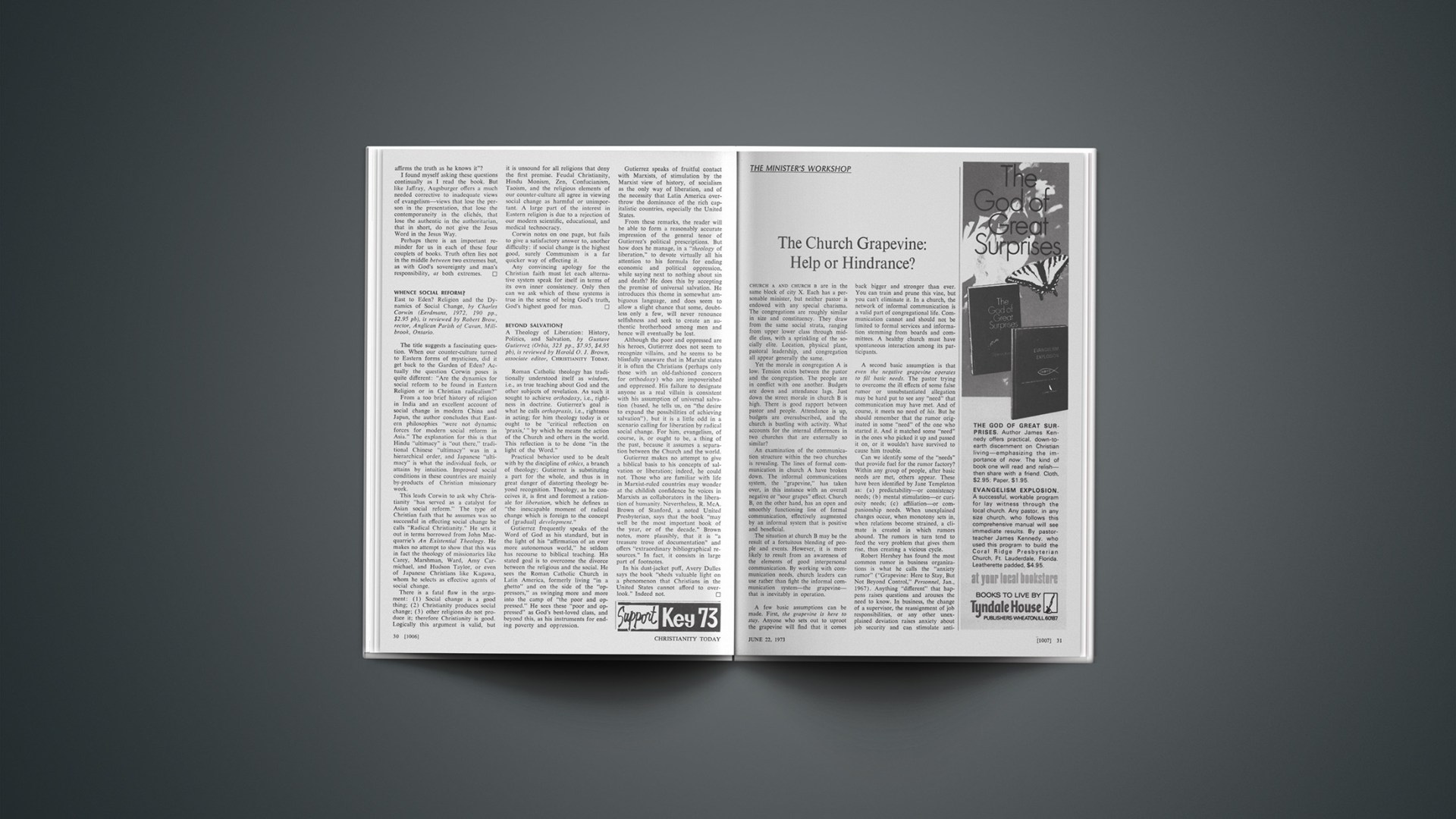Church a and church b are in the same block of city X. Each has a personable minister, but neither pastor is endowed with any special charisma. The congregations are roughly similar in size and constituency. They draw from the same social strata, ranging from upper lower class through middle class, with a sprinkling of the socially elite. Location, physical plant, pastoral leadership, and congregation all appear generally the same.
Yet the morale in congregation A is low. Tension exists between the pastor and the congregation. The people are in conflict with one another. Budgets are down and attendance lags. Just down the street morale in church B is high. There is good rapport between pastor and people. Attendance is up, budgets are oversubscribed, and the church is bustling with activity. What accounts for the internal differences in two churches that are externally so similar?
An examination of the communication structure within the two churches is revealing. The lines of formal communication in church A have broken down. The informal communications system, the “grapevine,” has taken over, in this instance with an overall negative or “sour grapes” effect. Church B, on the other hand, has an open and smoothly functioning line of formal communication, effectively augmented by an informal system that is positive and beneficial.
The situation at church B may be the result of a fortuitous blending of people and events. However, it is more likely to result from an awareness of the elements of good interpersonal communication. By working with communication needs, church leaders can use rather than fight the informal communication system—the grapevine—that is inevitably in operation.
A few basic assumptions can be made. First, the grapevine is here to stay. Anyone who sets out to uproot the grapevine will find that it comes back bigger and stronger than ever. You can train and prune this vine, but you can’t eliminate it. In a church, the network of informal communication is a valid part of congregational life. Communication cannot and should not be limited to formal services and information stemming from boards and committees. A healthy church must have spontaneous interaction among its participants.
A second basic assumption is that even the negative grapevine operates to fill basic needs. The pastor trying to overcome the ill effects of some false rumor or unsubstantiated allegation may be hard put to see any “need” that communication may have met. And of course, it meets no need of his. But he should remember that the rumor originated in some “need” of the one who started it. And it matched some “need” in the ones who picked it up and passed it on, or it wouldn’t have survived to cause him trouble.
Can we identify some of the “needs” that provide fuel for the rumor factory? Within any group of people, after basic needs are met, others appear. These have been identified by Jane Templeton as: (a) predictability—or consistency needs; (b) mental stimulation—or curiosity needs; (c) affiliation—or companionship needs. When unexplained changes occur, when monotony sets in, when relations become strained, a climate is created in which rumors abound. The rumors in turn tend to feed the very problem that gives them rise, thus creating a vicious cycle.
Robert Hershey has found the most common rumor in business organizations is what he calls the “anxiety rumor” (“Grapevine: Here to Stay, But Not Beyond Control,” Personnel, Jan., 1967). Anything “different” that happens raises questions and arouses the need to know. In business, the change of a supervisor, the reassignment of job responsibilities, or any other unexplained deviation raises anxiety about job security and can stimulate anti-management attitudes. Economic values are not generally at stake in a church relationship, but spiritual values are. Often people view the church as a bulwark against change in a too-fast changing world. When changes are instituted, they can arouse anxiety that causes foot dragging and resistance.
Another rumor that Hershey identifies is the “wish-fulfillment rumor.” The pay raise or increased pension benefits you want easily find their way to the rumor circuit before formal announcements are made. This is the opposite of the anxiety reaction just described. Instead of wanting to hold things the same, this response looks for change, for something new and exciting. How many tales get started out of sheer boredom? I always smile when I read Paul’s description of the Athenians who “spent their time in nothing else but either to tell or to hear some new thing.” Again, some project their unfulfilled wish for perfection onto the minister or the church. When these fail to meet expectations, bitterness sets in. And of course it is a well-known psychological principle that “saints” often enjoy the “sins” of others vicariously through choice bits of gossip.
The third kind of rumor Hershey identifies is the “wedge-driving rumor.” Everyone wants to enhance himself in the eyes of others. To be in the know has a special appeal. But the wedge-driving rumor is the result of affiliation needs or of social relations gone sour. It springs from the desire to enhance one’s own position by downgrading that of another, or to gain the esteem of one at the expense of another.
These random comments may be enough to show how the normal desires for consistency, for mental stimulation, and for social relations can be distorted to stimulate rumors based on anxiety, wish fulfillment, or wedge-driving attitudes.
A third basic assumption about the grapevine is that leadership style influences the grapevine. Can steps be taken to insure that the spontaneous, informal communication within the church operates to its benefit rather than its detriment?
First, provide full information. Speculation breeds on incomplete information. The human mind doesn’t like gaps. It will attach its own significance to an event that is not fully explained. And more often than not it will take a negative view of that which it does not understand.
Unfortunately, most churches do not provide an adequate budget or sufficient office help to enable the minister to generate the flow of information necessary to keep the congregation fully informed. When the minister has to choose between spending his time with the mimeograph or with the people, he loses either way. Individual contact cannot keep the congregation adequately informed, but no amount of printed material can provide the dimension of depth that personal contact allows. Many a church newsletter falls wide of the mark because it is designed to meet the minister’s need to tell rather than the parishioners’ need to know.
Second, develop a style that is open to feedback. Both the minister and the congregation may have to work at opening up a free interchange of information. When the minister is on a pedestal, it is no wonder if the whole performance of the church takes on the appearance of a charade and problems in understanding are never dealt with.
The minister himself may create a wall that feedback cannot penetrate. However, if he can learn to feel at ease with differences of opinion, if he can develop the ability to listen constructively, if he can react without defensiveness, if he can lift others in their own self-esteem, if he can allow them a true sense of participation, he will have gone a long way toward creating a climate in which the grapevine will operate positively rather than negatively.
Third, use the natural patterns of communication that exist within the church. An effective church is properly organized with boards and committees to carry on the work of the church. But the alert leader will also be aware of patterns of flow that exist apart from these charts. Keith Davis has identified four ways in which informal communications travel through an organization:
1. The single-strand method, from one person to another in a chain.
2. The gossip pattern, in which one person tells everyone he sees.
3. The probability pattern, in which information spreads through contacts within the organization.
4. The cluster pattern (the most frequent), in which one person tells two or three persons, who each tell two or three more, and so on (“Management, Communication, and the Grapevine,” Harvard Business Review, September, 1953).
Using these patterns, a pastor may learn several key points that he can touch to get the pulse of what’s happening or to disseminate information quickly. The free flow of information, the development of a climate of mutual trust and openness, and the deliberate use of informal communications channels are effective means to higher levels of morale and motivation.—WENDEL CRAKER, pastor, Winder Wesleyan Church, Winder, Georgia.










